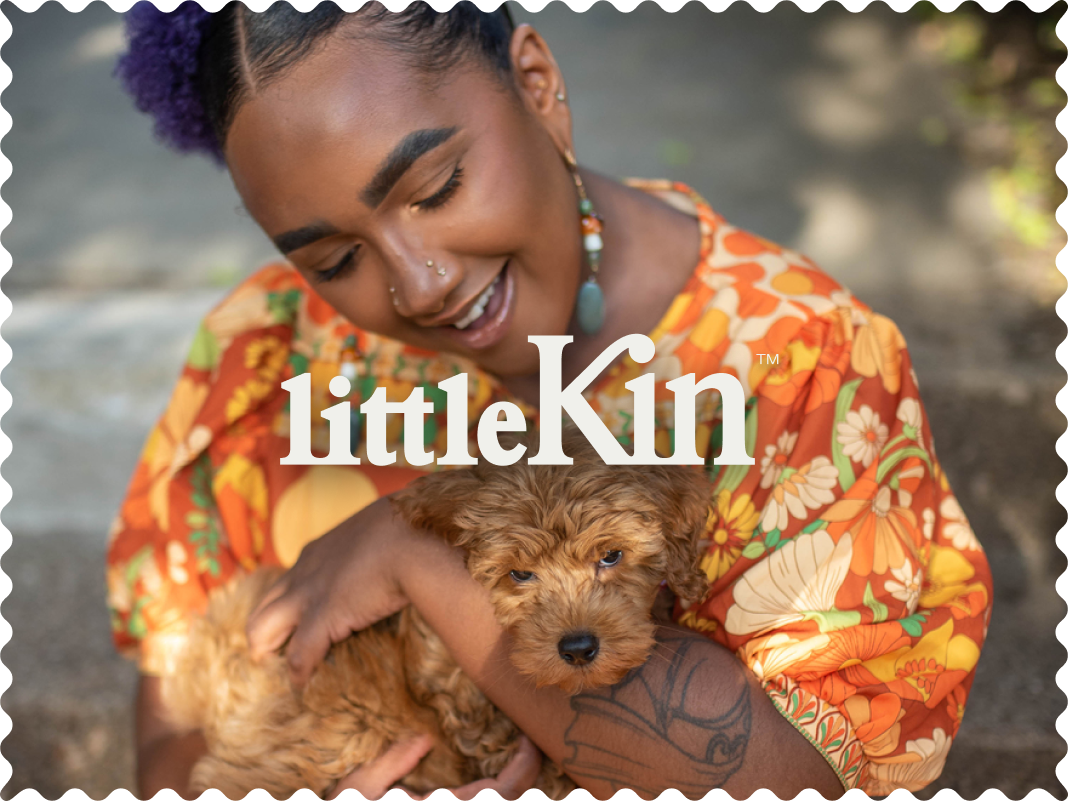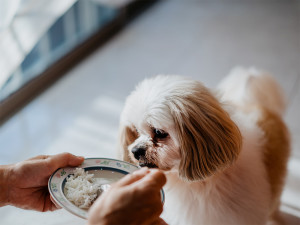How to Add More Fiber to Your Dog’s Diet
Learn what can give them a little boost.

Share Article
In This Article:
Health Benefits of Fiber What To Feed a Dog With Diarrhea High Fiber Dog Foods Canine Fiber Supplements High Fiber Vegetables and Fruits for Dogs
Fiber is well-known as a super nutrient, and it’s no surprise that many dogs benefit from eating a fiber-rich diet, too. Nearly all dogs need fiber as part of a healthy, balanced meal, and all dog food diets you can buy at the store provide enough for their daily intake. In some cases, additional fiber may be beneficial in managing medical conditions including constipation, anal gland problem s, diabetes, certain kinds of chronic diarrhea, or obesity.
Many of the foods we know to be essential to a healthy diet, like vegetables, fruits, and whole grains, are all rich in fiber. Dog foods all contain fiber as well, with some higher in fiber than others. There are also fiber supplements that may be useful for curating exactly what kind of fiber and how much fiber you give your dog. It is important to know that fiber is a general category of many different nutrients that have varying functions in the body. While some kinds of fiber can help to firm up soft poop, others cause soft poop. Therefore, you’ll want to take your time figuring out what kind of fiber is best for your pup and how best to incorporate it into your dog’s diet. Read on to learn more about fiber for dogs.

Health benefits of fiber
Fiber is a non-digestible carbohydrate that provides many health benefits in the body. Some of the main benefits include modifying the speed of digestion, providing nutrients for the good microbes in the gut, and creating feelings of fullness. Therefore, fiber can promote good digestive health and help dogs feel full without eating as many calories.
It also helps to stabilize blood sugar, which is important for diabetic dogs. Tweaking a dog’s fiber intake can also help with specific digestive conditions. For example, a dog with constipation may benefit from certain kinds of fiber that will speed up the passage of material through the digestive tract and draw additional water into their colon to soften their poop. A dog with anal gland problems may need a different kind of fiber that will add bulk to their stool. Finally, a dog with chronic diarrhea may respond to fiber that slows the speed of digestion and promotes more solid poop.
It is important to consult with a veterinarian if you intend to use fiber to help manage your dog’s medical condition. You’ll want to make sure to select the right type of fiber for your dog’s needs and to make sure it isn’t contraindicated with your dog’s other treatments. Fiber should always be introduced gradually to give your dog’s body a chance to adjust; a sudden increase in fiber can cause bloating, pain, gas, or diarrhea.
What to feed a dog with diarrhea
You probably didn’t anticipate that so much of dog parenting revolves around poop; analyzing your dog’s poop, cleaning up poop, and obsessing about how to improve your dog’s poop is a big part of caring for your pup. When your dog has diarrhea, it can be distressing for both of you and understandably, you want to cure it right away. The first step should always be to see your vet as many causes for diarrhea are curable with the right medication.
In the short term, dogs with acute diarrhea may need to eat an easily digestible diet for a few days until the inflammation in their intestines resolves. These diets are usually lower in fiber and contain a mix of lean protein and simple carbohydrates. In these cases, fiber could make diarrhea worse because it is harder to digest. However, for dogs who have ongoing, chronic soft stool or diarrhea, increased fiber may be part of the treatment plan.
Depending on the suspected cause of a dog’s diarrhea, this may include a specialized prescription diet, supplements, or medications. Some dogs with chronic diarrhea may respond to increased fiber in their diet, either through a high-fiber diet or a fiber supplement for dogs. It is important to remember that there are many kinds of fiber out there, and some can make a dog’s diarrhea worse instead of better. Usually a soluble fiber, like psyllium, is a good choice and it should be introduced gradually in consultation with your vet.
High-fiber dog foods
One way to increase your dog’s daily fiber intake is by transitioning them to a high-fiber dog food option. The benefit of this approach is that the fiber is built into the diet so you don’t have to fuss with finding a supplement that your dog will actually eat or the trial and error of figuring out how much to give your pup. The downside of selecting a high-fiber dog food is that there is a fixed amount of fiber in there, so you won’t have the ability to adjust the fiber content.
A diet change is also a long-term commitment since you’ll need to spend a few weeks gradually introducing the diet and transitioning your dog to the new food. When assessing the fiber content of dog food, it is most helpful to know the total dietary fiber as opposed to the crude fiber content. While not every dog food label will provide this information, total dietary fiber is a more accurate measurement of the true fiber content of the diet. Even better, some diets will specifically break down the content of soluble versus insoluble fibers, which is important to know for managing different conditions.
If your dog needs a high-fiber diet for their medical condition, your vet will likely prescribe a diet that has a specific amount of total dietary fiber and a certain ratio of soluble to insoluble fiber to target their needs. Beware of over-the-counter diets that claim to be high in fiber but do not provide this information. In that case, it will be impossible to know how much fiber they actually contain and whether they have the right blend of soluble and insoluble fibers.
Canine fiber supplements
Fiber supplements are another way to increase your dog’s fiber intake without messing with their food. If you have a picky dog who is unlikely to accept a whole new diet, or your dog needs another kind of specialized diet for other reasons, switching them to a high-fiber dog food may not be an option. Instead, a fiber supplement for dogs can be added to their food. Many of the supplements are flavorless, so this can be a good solution for finicky pups. Plus, using a supplement gives you complete control over how much to add so you can find what works best for your pup.
Some common fiber supplements are made from psyllium, wheat bran, or inulin. It is important to make sure the supplement you choose is safe for dogs and does not contain added sugar, flavorings, or potential toxins, like xylitol. You’ll also want to consult with your vet as to which supplement is best for your dog’s condition. Psyllium is a mix of mostly soluble fiber with a small amount of insoluble fiber, inulin is considered a soluble fiber, and wheat bran contains mostly insoluble fiber. Soluble fiber dissolves in water and is known to help with diarrhea. Insoluble fiber does not dissolve in water and helps with constipation.
High fiber vegetables and fruits for dogs
Fruits and vegetables can also be a good source of fiber along with other important nutrients. It is important to double-check that foods are safe and non-toxic for dogs before sharing them. Also, keep in mind that while whole foods provide lots of added nutritional benefits, they often have variable amounts of fiber and will not contain as much concentrated fiber as a supplement or specialized diet. They also add calories and fat to the diet. Fruits and vegetables are best used as occasional snacks; they are not as effective as a therapeutic treatment. Some safe, high-fiber options for dogs include:
Green beans: Crunchy green beans can be a satisfying snack for dogs.
Sweet potatoes: Sweet potatoes have many healthy nutrients but also contain more sugar and starch than a lot of other fruits and vegetables and should only be offered in small amounts.
Apple (with skin): Most of an apple’s fiber is in the skin so try to serve small amounts of skin with the fruit.
Carrots: Crunchy and satisfying, many dogs love carrots. They are higher in starch than some other options, so use sparingly, especially for dogs that are overweight or diabetic.
Broccoli: High in fiber and low in calories, broccoli is a good choice for many dogs, too.
Raspberries: Raspberries are one of the highest-fiber foods out there, so go slow when introducing these to your dog.
Pear (with skin): The skin of the pear is full of fiber, so if you want to maximize your dog’s fiber intake, serve small pieces of pear with the skin on. Pears are high in sugar, so these should be offered only occasionally.
Spinach and kale: High-fiber, dark, leafy greens can be served raw or cooked.
Pumpkin: While many pet parents use canned pumpkin as a fiber supplement and it is a good option, it is actually lower in fiber than many other fruits and vegetables, like the ones listed above.
When to seek expert help
It is a good idea to consult your vet before making a big change to your dog’s fiber intake. Fiber is a complex nutrient that has many important roles in the body. Like many valuable tools in medicine, it can have huge benefits when used appropriately but has the potential to cause many undesirable effects when applied improperly.
Therefore, you’ll want to discuss your specific concerns with your vet, and what you hope to accomplish by adding more fiber to your dog’s diet. This will help you and your vet figure out the best approach, as well as the right kind of fiber to target your dog’s needs.
Bottom line:
Fiber includes many different kinds of nutrients that have different effects in the body.
When adding fiber to your dog’s diet, you’ll want to consider the specific type of fiber, as well as how much total fiber to give your dog.
Be sure to consult a vet before adding a lot of fiber to your dog’s diet; in some cases it can be contraindicated.
References
Alves, JC, et al. “The use of soluble fibre for the management of chronic idiopathic large-bowel diarrhoea in police working dogsopens in new tab.” BMC Veterinary Research, vol. 17, no. 100, 2 March 2021.
Heinze, C. “Fiber frustrationsopens in new tab.” Cummings School of Veterinary Medicine Petfoodology, 4 November 2019.
Phungviwatnikul,T, et al. “Weight loss and high-protein, high-fiber diet consumption impact blood metabolite profiles, body composition, voluntary physical activity, fecal microbiota, and fecal metabolites of adult dogsopens in new tab.” Journal of Animal Science, vol. 100, no. 2, February 2022.

Dr. Amy Fox, DVM
Amy Fox, DVM is a small animal veterinarian in New York City with over thirteen years of experience in a mixture of general practice, emergency medicine, and shelter medicine. A lifelong animal lover, Dr. Fox studied biology in college and then worked as a veterinary nurse before pursuing veterinary school at Cornell University. Her expertise includes surgery, dentistry, and management of chronic conditions, and she is interested in toxicology, pain management, nutrition, care of senior pets, and educational outreach. Dr. Fox also enjoys writing about veterinary medicine and teaching, and her work has previously appeared in Spruce Pets. In her free time, she loves to cook, garden, go for long runs, and hang out with her goofy mixed-breed dog May, who provides never ending comic relief!
Related articles
What Can You Give Your Dog for Constipation?
Here are some ways to get things moving again.
![A person giving a banana to a dog.]()
10 Fruits and Vegetables That Your Dog Can Feast On
Indulge your pup (safely) with these delicious and healthy snacks.
![Pug dog scooting on a wooden floor in the kitchenFunny dog enjoying scratching his bum on grass at public dog park.]()
Home Remedies For Dog Scooting
A vet on what to do when “anal sacs go bad.”
Can You Give Dogs Tums?
Learn what’s safe to do when they have tummy troubles.
![Pet owner feeding white rice to her Shih Tzu dog.]()
Can Dogs Eat Rice? And More Importantly, Should They?
Yes, actually. Just follow these guidelines.
![Puppy eating a bowl of blueberries]()
10 Superfoods You Should Share With Your New Dog
From kale to quinoa, these nutrient-packed picks deserve a spot in your dog’s food bowl.








